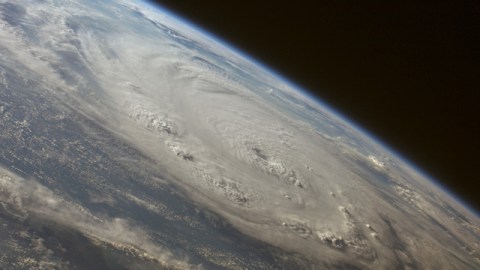#27: Control the Weather

Using lasers to manipulate the weather sounds like science fiction, but researchers at the University of Geneva have done just that. In May, Dr. Jerome Kasparian unveiled the results of a study which used a high-powered laser to simulate rain cloud formations.
Kasparian told Big Think that the genesis of his group’s experiment came from an ongoing controversy about the possible contribution of cosmic rays to cloud formation, based on the ionization of the air that would promote the formation of clusters which then grow into particles and then into droplets. “We have very high-powered lasers that can ionize the air much more efficiently than cosmic rays,” says Kasparian, “and we thought if the cosmic rays can have an effect, the laser should too.” And, sure enough, the laser created tiny rain droplets both in controlled lab settings and in the atmosphere.
Water requires a non-gaseous surface to transition from a vapor to liquid. So for rain to form there must be both humidity in the air as well as small particles called condensation nuclei, which provide these surfaces on which the water molecules can condense. Effectively, Kasparian’s laser created ionized particles that mimicked condensation nuclei.
This is the same idea behind cloud seeding, a controversial technology that purports to trigger rain by seeding clouds with particles like silver iodine. These particles, whether dropped into clouds from airplanes or shot into them with cannons, supposedly act as artificial condensation nuclei, triggering rain. The U.S. first developed cloud-seeding technology after World War II in an attempt to control hurricanes, but most of the experiments (conducted under the names Project Cirrus and Project Stormfury), were deemed a failure. Kasparian told us that, despite many experiments, cloud seeding is very difficult to verify because it is difficult to have control conditions. “You launch your silver iodine and get some rain, but you don’t know what would have happened otherwise.”
Nevertheless, China claims to have perfected the science behind cloud seeding. Between 2001 and 2005, nearly 3,000 flights triggered 210 billion cubic meters of water over an area making up nearly a third of China’s territory, according to an official from China’s National Meterological Bureau. The problem, Kasparian says, is that “the Chinese only communicate the results of their experiments afterward.” They may try 10 times and fail, but if the only communicate the results of the one time it begins to rain (naturally or triggered by the silver iodine), the technology seems to work.
But Kasparian’s work with lasers has returned an air of scientific respectability to this effort. And last year the former world’s-richest-man, Bill Gates, also got into weather control, applying for a patent with 11 others for a technology to cool down ocean surface temperatures, thereby weakening hurricanes. Hurricanes derive their destructive power from warm water temperatures at the surface of the ocean, so Gates’s idea is to construct hundreds of massive, vertical tubes in the ocean that would force warm water from the surface down to cooler depths. Named Salter sinks, these structures are explained in the following video.
Kerry Emanuel, a hurricane expert from MIT, believes that this technology is feasible. Cutting the temperature of the ocean by just 4.5 degrees Fahrenheit beneath the eye of a storm could effectively kill it, he says. According to a study published in Natural Hazards Review in 2008, hurricanes have caused $10 billion in damage annually over the past century. Minimizing the damaged caused by hurricanes might help to cover the cost of Gates’s plan.
Takeaway
Man has always dreamed of taming the heavens, and Kasparian’s experiment is a step toward that goal. If this technology is developed further it could have huge implications for agriculture. And if these more radical attempts to control hurricanes prove fruitful, they could save thousands of lives and billions of dollars. Hurricane Katrina, alone, is estimated to have cost between $80 and $125 billion, making it one of the most expensive natural disasters in U.S. history.
U.S. weather modification technology lags far behind that of China, which invests roughly $100 million annually in controlling the weather. “It’s the epicenter of all weather modification activity,” says Bill Woodley, a former researcher with the National Oceanic and Atmospheric Administration.
Why We Should Reject This
Controlling the weather is such a potentially dangerous technology that the United Nations banned its use in wartime in 1977—before the relevant technology even existed. Though the sort of weather warfare that may have seemed plausible in the ’70s will probably never be possible, there are still dangers to even modest weather manipulation. When weather patterns are altered to suit one area or population, there will likely be adverse effects for someone else.
As for Gates’s plan to cool surface temperatures using Salter sinks, the cost would be astronomical. To hurricane-proof just the southern Atlantic and the Gulf of Mexico (assuming that it would work in the first place) would require coverage of 528,000 square miles of ocean, says Neal Dorst of the Hurricane Research Division of the National Oceanic and Atmospheric Administration.
More Resources
—”Laser induced water-condensation in air” (2010) co-authored by Kasparian [PDF]
—Natural Hazards Review study (2005) on the damage cause by hurricanes in the last century [PDF]
—Study on weakening hurricanes published in Journal of Weather Modification (2006) by Moshe Alamaro [PDF]





